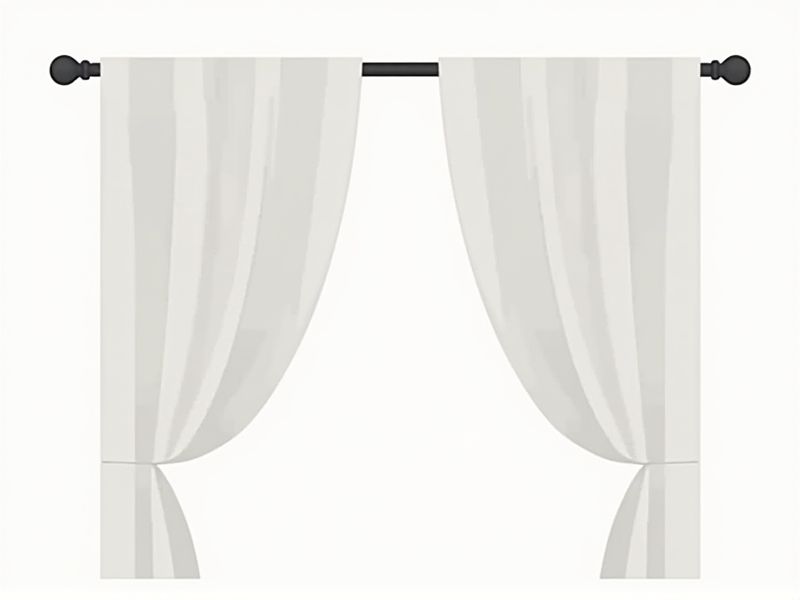
When selecting a curtain rod, it's helpful to know the standard dimensions to ensure proper fit and function. Most curtain rods typically range in diameter from 1/2 inch to 1 1/4 inches, with 1 inch being a popular choice for many household curtains. The standard adjustable length for curtain rods usually starts at 28-48 inches, 48-84 inches, or even 66-120 inches to accommodate various window sizes. To achieve the best results, measure your window width and allow extra length on both sides, so your curtains fully frame your window when open.
Rod Diameter
When selecting a curtain rod, the rod diameter is a crucial factor that significantly impacts both functionality and aesthetics. Standard diameters typically range from 1 inch to 1.25 inches for lightweight curtains, while heavier drapery often requires rods measuring 1.5 inches or more for optimal support. A thicker rod not only enhances durability but also provides a more elegant appearance, complementing your interior design. To determine the best fit, consider the weight of your curtains, aiming for a rod diameter that can adequately support them without sagging or bending.
Rod Length
The standard curtain rod length typically ranges from 28 to 144 inches, accommodating various window sizes and configurations. When selecting your rod, consider that it should extend 3 to 6 inches beyond the window frame on each side, allowing for better light control and aesthetic appeal. The diameter of the rod usually varies between 1 inch and 2 inches, with thicker rods offering increased durability and a more premium look. Lastly, adjustable curtain rods are available, providing flexibility in length to ensure a perfect fit for your specific window dimensions.
Bracket Projection
Bracket projection is crucial in determining the overall functionality and aesthetic of your curtain rod setup. A typical bracket projection ranges from 3 to 6 inches, allowing curtains to hang properly while minimizing light leakage. Selecting the correct projection ensures that your drapes can stack back neatly, enhancing the visual appeal and usability of your window treatment. For optimal results, you should consider your curtain's fabric thickness and fullness when choosing the appropriate bracket projection.
Finial Size
The finial size on a curtain rod significantly impacts both functionality and aesthetics, with standard measurements typically ranging from 2 to 6 inches in diameter. Choosing the right finial can enhance the overall style of your room, as decorative options include ornate designs, sleek modern finishes, and natural materials. Larger finials, around 4 to 6 inches, create a bold statement, while smaller options offer a subtle touch. When selecting your curtain rod, consider the finial size in relation to the design and scale of your windows for an harmonious appearance.
Rod Material
When selecting a curtain rod, the material significantly impacts durability and aesthetics. Common materials include stainless steel, known for its resistance to rust and corrosion, and wood, which offers warmth and a classic look. Aluminum rods are lightweight and ideal for larger windows, while wrought iron provides strength and can support heavy curtains. Your choice of rod material can affect both the longevity of the curtain system and the overall style of your room, helping to create the desired ambiance.
Rod Weight Capacity
The rod weight capacity for curtain rods typically ranges from 20 to 50 pounds, depending on the material and design. For example, a sturdy metal rod can support heavier drapery, while a wooden rod might be limited to around 25 pounds. When selecting a curtain rod, consider the combined weight of the curtains, any additional accessories, and the rod itself to ensure proper support. You should also evaluate the installation hardware, as the brackets and wall anchors significantly influence the overall weight capacity.
Rod Style
Curtain rods are available in various styles, including tension, traverse, and decorative options, each serving distinct functional and aesthetic purposes. A tension rod typically ranges from 28 to 48 inches in length, perfect for compact spaces, while traverse rods can extend from 48 to 144 inches and are designed for sliding drapery. Decorative rods, often featuring finials, can transform your room's look, with diameters typically between 1 and 1.5 inches for a sturdy appearance. Choosing the right style ensures a cohesive design while enhancing your window treatment's functionality and overall appeal.
Adjustable Length Option
An adjustable curtain rod offers flexibility, accommodating window widths ranging from 28 to 48 inches or even up to 144 inches, ensuring a perfect fit for various room dimensions. This feature allows you to customize your window treatment, enhancing aesthetic appeal while improving functionality. With strong materials such as steel or aluminum, an adjustable curtain rod can support heavy drapes, allowing for weights of up to 20 pounds. Installing such a rod is typically straightforward, requiring minimal tools and about 30 minutes of your time.
Rod Mounting Type
The standard curtain rod mounting types include wall-mounted, ceiling-mounted, and bracket-mounted options. Wall-mounted rods are the most common, typically requiring a spacing of 4 to 6 inches above the window frame for optimal light control and aesthetic appeal. Ceiling-mounted rods provide a sleek look and are ideal for rooms with high ceilings, effectively maximizing vertical space. Bracket-mounted rods allow for adjustable placement and can accommodate various curtain styles, enhancing your room's overall design.
Curtain Compatibility
Selecting the right curtain rod requires considering curtain compatibility to enhance both functionality and aesthetics. Various rod types, such as tension, traditional, and traverse rods, accommodate different curtain styles, including eyelet, tab top, and pleated. For example, a tension rod is ideal for lightweight curtains, while a sturdy wooden or metal rod can support heavier drapes. When choosing your curtain rod, ensure it matches the curtain's width, typically allowing for an extra 3-6 inches on each side for optimal light control and visual appeal.
